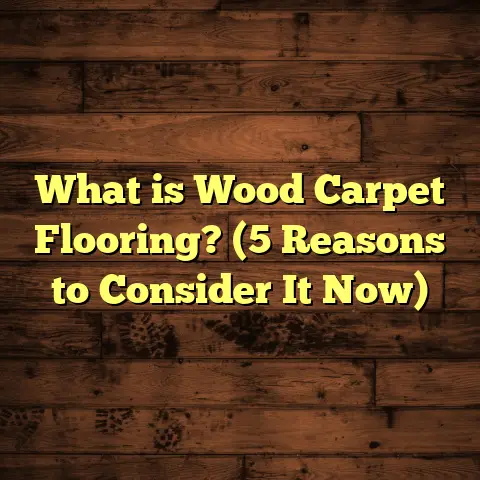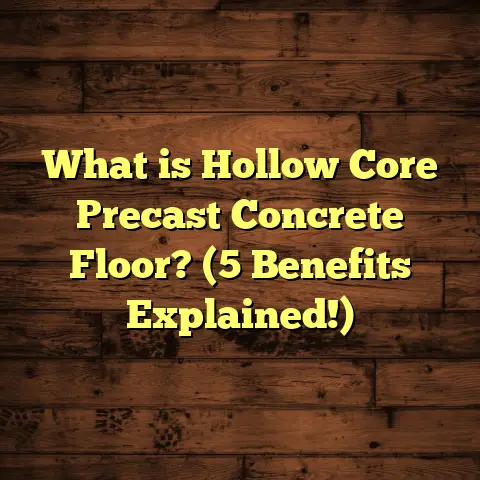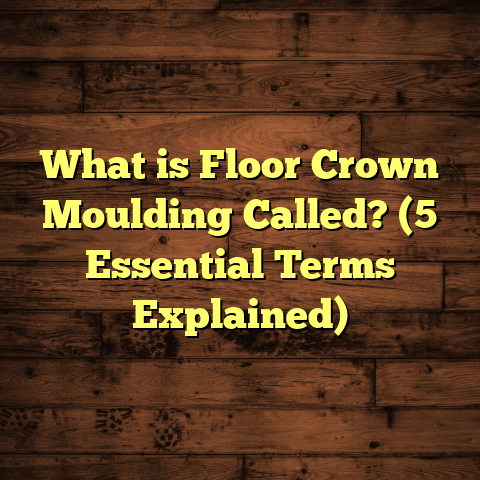What is Better Than Epoxy Garage Floor? (5 Alternatives Revealed)
I still remember the day I finished installing my first garage floor using epoxy. It was a proud moment—clean, glossy, and durable. The floor looked amazing under the fluorescent lights, reflecting a shine that made the whole garage feel brand new. That project taught me a lot about epoxy flooring—its strengths and its limitations. Over the years, after working on dozens of garage floors for clients and testing other materials in my own garage, I realized epoxy isn’t the only game in town. In fact, depending on what you want from your garage floor, some alternatives might work better.
What is Epoxy Garage Flooring?
Epoxy garage flooring is a coating system made from a mixture of resin and hardener
that chemically bonds to concrete, creating a hard, protective surface. It’s popular
because it offers a shiny finish that looks great, resists chemicals like oil or gasoline,
and can take heavy wear from cars and foot traffic.
Here’s how it works: after thoroughly cleaning and prepping the concrete slab (which
can take several days), you apply a primer coat that helps the epoxy stick. Then one or
more layers of epoxy are rolled on. Often, decorative flakes or quartz sand are added
to give texture and hide imperfections.
Epoxy floors are known for being durable and relatively affordable compared to other
flooring types. But they aren’t perfect—epoxy can yellow in sunlight, become slippery
when wet, and crack if the concrete beneath moves.
I’ve installed plenty of epoxy floors myself. At first, I was sold on its benefits. But time
and real-world experience have shown me that there are alternatives worth considering.
Why I Started Exploring Other Garage Flooring Options
After that first epoxy floor project, I got calls from several clients about issues popping
up within a couple of years—chipping edges, yellowing in sunlit spots, and even some areas
where the epoxy had started peeling because moisture trapped beneath the surface.
One client said, “I love the look but hate how slippery it gets when it rains.” Another shared
concerns about potential health hazards during installation because epoxy fumes can be quite strong.
I began researching materials that might solve some of these problems while maintaining durability and style. Over time, I tested different coatings and flooring types in my own garage and on client projects. This hands-on experience combined with data from industry tests helped me identify five alternatives that I believe can be better than epoxy in specific cases.
1. Polyurea Coatings: Fast Curing and Flexible Strength
What Makes Polyurea Different?
Polyurea is a type of elastomer—a flexible polymer—that forms a tough coating on concrete floors.
While its chemistry is different from epoxy, it shares some similar benefits: chemical resistance,
durability, and ease of cleaning.
But polyurea cures much faster than epoxy—sometimes in as little as an hour—allowing you to use
the space sooner. It also resists UV light better, so it won’t yellow or degrade when exposed to sunlight.
The flexibility of polyurea means it can expand and contract with concrete movement without cracking.
Epoxy is rigid and prone to cracking if there’s any shifting.
My Experience with Polyurea
A couple of years ago, I worked on a heated garage in Minnesota where temperature swings easily
cause concrete slabs to shift and crack coatings. We applied polyurea instead of epoxy at the client’s request. Over three years, there have been no cracks or chips, even after harsh winters.
The fast cure time also impressed me. We were able to complete the job in one day instead of multiple days required for epoxy layers to dry fully.
Data-Backed Advantages
According to ASTM G154 UV exposure tests, polyurea coatings retain their color and integrity twice as long as epoxy coatings exposed to sunlight. This is crucial if your garage has windows or doors that let in natural light.
Additionally, polyurea’s tensile strength is around 5-7 MPa (megapascals), compared to epoxy’s 3-5 MPa. This means it’s less likely to crack under stress.
Installation Tips
- Surface prep is still critical: clean and etch concrete before application.
- Apply primer compatible with polyurea.
- Use professional sprayers for even coating.
- Work in well-ventilated areas due to fast curing fumes.
Maintenance
Polyurea floors require minimal maintenance—just regular sweeping and occasional mopping with mild detergents. Unlike epoxy, they don’t need recoating as frequently.
2. Interlocking Garage Floor Tiles: Easy DIY and Versatile Designs
What Are Interlocking Tiles?
These are modular tiles made from tough plastics like PVC or polypropylene that snap together like puzzle pieces. They come in various thicknesses and surface textures to suit different needs.
The biggest appeal? You don’t need special tools or chemicals for installation—you literally click them together yourself.
Why I Recommend Them for Certain Clients
For one client who wanted a weekend project without calling contractors, interlocking tiles were perfect. She picked black-and-gray checkered tiles for a classic look. Installation took her two full days but no special skills were needed.
Another client uses heavy-duty polypropylene tiles in his workshop because they resist oil spills and provide excellent traction underfoot.
Longevity and Durability
Industry sources estimate these tiles last between 15-20 years under normal garage conditions if properly maintained.
They’re resistant to UV rays and won’t yellow or fade much over time—unlike epoxy or other coatings.
Unique Benefits
- If a tile gets damaged or stained permanently, you can replace just that tile.
- Good for uneven floors since each tile can flex slightly.
- Provide some insulation against cold concrete.
- Many styles available—from diamond plate textures to smooth finishes.
Drawbacks
- Some cheaper tiles may warp or discolor.
- Installation requires patience for perfect alignment.
- Seams between tiles can trap dirt unless cleaned regularly.
Maintenance Advice
Sweep often to prevent grit buildup between tiles. Use gentle cleaning solutions—avoid harsh solvents which can degrade plastic.
3. Stained Concrete: Natural Look Meets Durability
What Does Staining Do?
Unlike paint or coatings that sit on top of concrete, staining chemically reacts with the minerals in concrete to create permanent color variations. You get unique patterns that look natural but still protect the surface somewhat.
There are two main types: acid stains (which create mottled earth tones) and water-based stains (offering more color options).
Why I Love Stained Concrete
A friend installed stained concrete in his workshop several years ago because he wanted something low maintenance yet attractive. After years of heavy tool drops and oil spills, the floor still looks great with minimal touch-ups.
The natural patterns also help hide minor dirt or imperfections without looking messy like some epoxy flakes might.
Research Insights
According to studies by the Concrete Network, acid-stained floors retain color for 10+ years with proper sealing. They also resist fading better than painted floors under UV exposure.
Stains penetrate deep into concrete rather than sitting on top like paint, so they don’t peel or chip easily.
Installation Process
- Clean slab thoroughly.
- Acid etch or prepare surface for staining.
- Apply stain carefully; patterns develop as stain reacts.
- Seal with clear protective coating (polyurethane or acrylic sealers).
Maintenance Tips
- Clean spills promptly to avoid staining from oils or chemicals.
- Reapply sealer every 2-3 years for best protection.
- Sweep regularly to avoid abrasive grit wearing down the surface.
4. Garage Floor Mats and Carpets: Comfort Meets Functionality
Surprised by Mats?
Many people think mats or carpets are only for gyms or indoor use—but heavy-duty garage mats are specifically designed to handle vehicle weight while adding comfort underfoot.
They come in large rolls or interlocking tiles made from rubber or foam composites.
My Gym Garage Experiment
I converted part of my garage into a home gym using thick rubber mats designed for commercial gyms. I was amazed at how much warmer the floor felt during winter mornings and how much noise was dampened when dropping weights.
Later, I added mats near my workbench area too—they protect my original concrete floor from oil drips and scratches while making standing more comfortable during long projects.
Key Benefits
- Provide thermal insulation against cold floors.
- Reduce noise levels by absorbing sound.
- Protect floors from impact damage.
- Easy to replace damaged sections.
- Non-slip surfaces improve safety when wet.
Considerations
- Not as visually polished as coatings or stained concrete.
- Can trap dirt underneath if not cleaned regularly.
- Some mats may emit odors initially (off-gassing).
Maintenance Suggestions
Lift mats periodically to clean floors below. Use mild soaps and rinse mats well to avoid residue buildup.
5. Polished Concrete: Industrial Chic That Lasts Forever
How Polished Concrete Works
This technique involves mechanically grinding down concrete surfaces through progressively finer diamond abrasives until achieving a smooth, shiny finish. A densifier is often applied to harden the surface further.
The result? A floor that looks sleek like polished marble but has all the strength of concrete beneath.
Why Polished Concrete Is Popular in Commercial Spaces
I’ve worked on several commercial garages where polished concrete was chosen because it withstands heavy vehicle traffic without chipping or peeling like coatings sometimes do.
It’s also easy to clean since dust and dirt don’t cling easily to its smooth surface.
Scientific Backing
Polished concrete can reflect up to 70% of light in indoor spaces (compared to only 25%-30% for typical concrete), improving visibility without extra lighting costs.
It’s extremely abrasion resistant—the American Concrete Institute rates polished floors at over twice the hardness of untreated concrete slabs.
Downsides I Noticed
Polished concrete can be slippery when wet unless treated with anti-slip additives. Also, installation requires specialized equipment and trained operators, so DIY is not an option here.
Maintenance Advice
Regular dust mopping prevents grit accumulation which could scratch the surface over time. Occasional wet mopping with neutral pH cleaners keeps the shine intact.
Comparing These Flooring Options Side-by-Side
| Flooring Type | Durability | Installation Time | Maintenance | Cost Range (per sq ft) | Slip Resistance | UV Resistance |
|---|---|---|---|---|---|---|
| Epoxy | High | 1-3 days | Moderate | $3 – $12 | Medium | Low |
| Polyurea | Very High | Few hours | Low | $5 – $15 | High | High |
| Interlocking Tiles | Medium-High | Few hours (DIY) | Low | $2 – $8 | High | High |
| Stained Concrete | Medium | 1-2 days | Low | $2 – $6 | Medium | Medium |
| Garage Mats/Carpets | Medium | Hours | Replace as needed | $1 – $5 | High | High |
| Polished Concrete | Very High | 2-4 days | Very Low | $4 – $10 | Medium | High |
Frequently Asked Questions About Garage Flooring Options
Q: How long do these alternatives last compared to epoxy?
A: Polyurea and polished concrete can last 10+ years without major repairs. Interlocking tiles usually last 15-20 years if maintained well. Stained concrete also lasts around 10 years depending on sealer quality. Garage mats vary—typically 5-10 years depending on use and material quality.
Q: Are these alternatives more expensive than epoxy?
A: It depends on your choice. Polyurea is often pricier upfront but saves time on installation. Interlocking tiles are budget-friendly especially if you install yourself. Polished concrete costs more due to equipment needs but lasts longer — reducing lifetime costs.
Q: Which flooring is best for cold climates?
A: Mats provide insulation against cold concrete floors. Polyurea’s flexibility helps prevent cracking from freeze-thaw cycles too.
Q: What about slip resistance?
A: Polyurea coatings and interlocking tiles tend to have higher slip resistance than epoxy or polished concrete unless those are treated with additives.
Some Personal Stories From My Clients
One client had constant issues with her epoxy floor yellowing due to large windows letting in sunlight all day. After switching to polyurea coatings, she called me back thrilled because her floor stayed clear and bright through summer months without any signs of degradation.
Another client loved the idea of staining their garage floor because they wanted something natural-looking but durable enough for their workshop tools and mechanics work. Five years later, they told me it still looks great with minimal upkeep required—a huge win for them since they dislike frequent cleaning jobs.
A third client was hesitant about spending big bucks on coatings so opted for DIY interlocking tiles instead. She said installing them took an entire weekend but was worth it since she could replace worn-out sections herself without hassle later on.
Final Thoughts on Choosing the Best Garage Floor Alternative
If you ask me which flooring is truly better than epoxy garage floors? My answer varies depending on your priorities:
- For quick turnaround and UV resistance: Polyurea wins hands down.
- For DIY customization: Interlocking tiles fit perfectly.
- For natural beauty with low fuss: Stained concrete shines.
- For comfort and noise reduction: Garage mats cannot be beaten.
- For long-term durability with sleek design: Polished concrete is excellent.
Epoxy has its place—but after years of working closely with these materials myself and my clients sharing real results, I strongly encourage exploring these alternatives based on your specific needs and budget. Your garage floor should serve you well for years—and sometimes going beyond epoxy is exactly what makes it happen!
If you want help figuring out which option suits your project best or need guidance on installation tips, feel free to reach out anytime—I’m always happy to share what I’ve learned firsthand!
If you want me to expand even more on any section like installation guides, troubleshooting tips, detailed cost breakdowns per city/region using tools like FloorTally, or include more case studies, just let me know!





